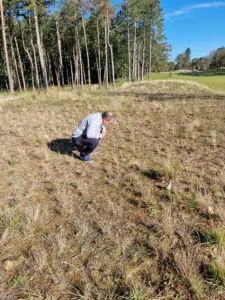Heather on the golf course: beautiful but complicated
Heather’s reintroduction sounds logical and simple at first when you talk about the North Sea islands. After all, the image of lush heathland adorns many a tourist advertisement that attracts guests to Sylt or other islands on the German coast. The reality is different: Heather restoration is not easy; it has its pitfalls. GC Sylt and GC Föhr have plenty of experience with this issue. Both traditional clubs have already undergone a golf course renovation.
After an initial redesign in 2015, a further renovation was completed at GC Föhr in 2022. The specifications of the accompanying landscape conservation plan were precise: the 27-hole course was to be given significantly more species-rich areas with plants typical of the island. Nutrient-poor grassland sites and heathland were required. The same applied to GC Sylt, which completed the renovation of ten holes in 2024. Here, too, heathland areas were to be created to reinforce the typical landscape character of the course.
Two main methods are used to restore heathland in particular: Planting and seed transfer. Both approaches have their advantages and disadvantages, which must be weighed up depending on the objective and site conditions. In the case of planting, heather plants are planted at predetermined locations. The plants are usually pre-grown in nurseries and then distributed over the area. The advantage is that the greening of the areas is quicker, and the plants are not as susceptible. “But then it’s not really genuine heather restoration,” points out Rolf-Stephan Hansen, board member of GC Sylt and landscape architect.
Traditional seed transfer, on the other hand, promotes natural regeneration. Seed is harvested from existing heathland areas and transferred to the selected areas. This seed often contains seeds of different heather species and companion plants, which promotes genetic diversity. The plants grow under local conditions from the outset and are often more resistant in the long term. However, the full development of the vegetation can take years to decades. Environmental factors such as precipitation, temperature or competition from other plants have a strong influence on success. Soil preparation is also often necessary for germination, for example by flattening or removing turf.
Subscribe to our newsletter!
News & trends about sustainability in golf
“Unfortunately, after three weeks, the first foreign growth was already on the fields,” says Rolf-Stephan Hansen looking back. Weeds, grasses and flowers were mixed in with all the seedlings from the Braderup Heath that had been sown as seed at GC Sylt. “Heather restoration then becomes very difficult because you have to ensure by hand that the vegetation doesn’t get out of hand,” says Hansen. At GC Sylt, the heathland had no chance of survival. Instead, the areas were transformed into species-rich meadows with seed mixtures from the region, which have developed very well. Since only mixtures for perennial plants were used, their value for biodiversity on the golf course is very high.
At GC Föhr, the heather establishment has worked better, at least in parts. However, President Ingomar Spieß, himself a biologist, painstakingly cleared the areas of foreign vegetation, in some cases with the help of members. He wants to start another attempt in 2025 on some areas where the heather was unable to establish itself.
The importance of maintaining extensive areas, in general, can also be clearly seen on the grounds of GC Föhr. The large areas beyond the tees and greens, often identified by golfers as untended natural areas, are quickly overgrown by plants that are particularly fast-growing or dominant. “The gorse has to be removed in many places,” Spieß has now realized. According to him, it is the main challenge for the greenkeeping team. Particularly in winter, rows of gorse bushes are removed, as the plant competes with heather or regional grasses in some areas. Weeping cherry and ragwort, both unpopular plants on golf courses, are also trying to assert themselves.
However, GC Föhr is determined to persevere with the heather issue. A total area of 25,000 square meters was planted with heather, some of which came from the North Sea island of Amrum and some from the Lüneburg Heath. “2023 was an extremely dry year, and strong easterly winds also made establishment more difficult,” recalls Spieß. A golf course is nature, and nature is increasingly unpredictable.








